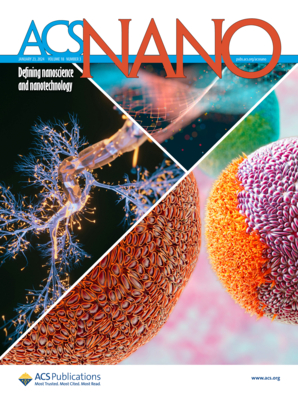Diazonium-Mediated Chemisorption and Polymerization of Aryl Ligands on Gold Nanoparticle Surfaces.
IF 16
1区 材料科学
Q1 CHEMISTRY, MULTIDISCIPLINARY
引用次数: 0
Abstract
Surface-capping molecular ligands are an integral part of virtually all colloidal inorganic nanoparticles that are chemically synthesized. The rational design of nanoparticle-adsorbate hybrid materials with specifically targeted properties and functionalities relies crucially on our understanding of ligand chemistry at the nanoparticle surfaces. Organic ligand molecules can interact covalently with metal surfaces through chemisorption using a variety of surface-binding moieties, most commonly thiol groups, to form self-assembled monolayers of monomeric adsorbates when reaching the saturated surface-coverage. Although monolayer formation of chemisorbed monomeric ligands on metal surfaces has been investigated intensively, diazonium-mediated surface-grafting of polymeric ligands remains underexplored and poorly understood, well-worthy of in-depth investigations. In this work, we use surface-enhanced Raman spectroscopy as a molecule-fingerprinting tool to study how aryl ligands evolve from monomeric adsorbates into surface-grafted branched polymers on nanotextured Au surfaces through diazonium-mediated chemisorption and polymerization. The results of our spectroscopic measurements reveal that the diazonium-mediated molecule-grafting process exhibits several singular characteristics, differing strikingly from the chemisorption of those monolayer-forming monomeric ligands. Through catalytic transfer hydrogenation reactions, para-nitrothiophenol monolayers on Au nanoparticle surfaces are chemoselectively converted into para-aminothiophenol via a bimolecular pathway with p,p'-dimercaptoazobenzene serving as a key intermediate, whereas the poly nitrophenylene multilayer ligands derived from the diazonium-mediated ligand-grafting process appear substantially more reactive upon exposure to hydrogen donors, evolving into surface-adsorbed aminobenzene via a fundamentally different reaction pathway involving rapid polymer decomposition followed by stepwise nitro reduction in monomeric adsorbates. This work provides useful insights that guide us to judiciously leverage diazonium-mediated ligand chemistry for advancing surface-functionalization of nanostructures and kinetic modulation of catalytic reactions toward a higher level of precision and versatility.重氮介导的芳基配体在金纳米颗粒表面的化学吸附和聚合。
表面覆盖分子配体是化学合成的几乎所有胶体无机纳米颗粒的组成部分。合理设计具有特定目标性能和功能的纳米颗粒-吸附物杂化材料,关键取决于我们对纳米颗粒表面配体化学的理解。有机配体分子可以通过化学吸附与金属表面共价相互作用,使用各种表面结合基团,最常见的是巯基,当达到饱和表面覆盖时,形成自组装的单体吸附剂单层。尽管人们已经深入研究了金属表面上化学吸附的单体配体的单层形成,但重氮介导的聚合物配体的表面接枝仍然没有得到充分的探索和了解,值得深入研究。在这项工作中,我们使用表面增强拉曼光谱作为分子指纹识别工具来研究芳基配体如何通过重氮介导的化学吸附和聚合,从单体吸附演变为纳米结构金表面上的表面接枝聚合物。我们的光谱测量结果表明,重氮介导的分子接枝过程表现出几个独特的特征,与那些单层形成的单体配体的化学吸附明显不同。通过催化转移加氢反应,金纳米颗粒表面的对亚硝基苯酚单层通过双分子途径以p,p'-二巯基偶氮苯作为关键中间体,化学选择性地转化为对氨基噻吩,而由重氮介导的配体接枝过程衍生的聚硝基苯多层配体在暴露于氢供体时表现出更强的反应性。通过一个完全不同的反应途径演变成表面吸附的氨基苯,包括快速聚合物分解,然后在单体吸附中逐步减少硝基。这项工作提供了有用的见解,指导我们明智地利用重氮介导的配体化学来推进纳米结构的表面功能化和催化反应的动力学调节,以达到更高的精度和多功能性。
本文章由计算机程序翻译,如有差异,请以英文原文为准。
求助全文
约1分钟内获得全文
求助全文
来源期刊

ACS Nano
工程技术-材料科学:综合
CiteScore
26.00
自引率
4.10%
发文量
1627
审稿时长
1.7 months
期刊介绍:
ACS Nano, published monthly, serves as an international forum for comprehensive articles on nanoscience and nanotechnology research at the intersections of chemistry, biology, materials science, physics, and engineering. The journal fosters communication among scientists in these communities, facilitating collaboration, new research opportunities, and advancements through discoveries. ACS Nano covers synthesis, assembly, characterization, theory, and simulation of nanostructures, nanobiotechnology, nanofabrication, methods and tools for nanoscience and nanotechnology, and self- and directed-assembly. Alongside original research articles, it offers thorough reviews, perspectives on cutting-edge research, and discussions envisioning the future of nanoscience and nanotechnology.
 求助内容:
求助内容: 应助结果提醒方式:
应助结果提醒方式:


